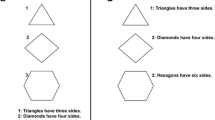Abstract
The conjoint retention hypothesis (CRH) claims that students recall more text information when they study geographic maps in addition to text than when they study text alone, because the maps are encoded spatially (Kulhavy, Lee, & Caterino, 1985). This claim was recently challenged by Griffin and Robinson (2000), who found no advantage for maps over feature lists in facilitating text recall. In two experiments, we crossed maps and lists with icons and names (c.f., Griffin & Robinson), and employed materials and methodology very similar to those used in previous CRH studies by Kulhavy and colleagues (Kulhavy, Stock, Verdi, Rittschof, and Savenye, 1993; Stock, Kulhavy, Peterson, Hancock, & Verdi, 1995). In addition, we included a concurrent task to measure spatial encoding, as did Griffin and Robinson. No advantages were found for maps over lists in facilitating text recall, nor were maps processed in a more spatial manner than litsts. Instead, it appears that the key stimulus feature for facilitating text recall is mimetic icons (i.e., icons that represent features) rather than the spatial characteristics of geographic maps, a finding that supports dual-coding theory (Paivio, 1986), but not the CRH.
Similar content being viewed by others
References
Abel, R. R., & Kulhavy, R. W. (1986). Maps, mode of text presentation, and children's prose learning.American Educational Research Journal, 23, 263–274.
Baddeley, A. (1992). Is working memory working? The Fifteenth Bartlett lecture.Quarterly Journal of Experimental Psychology, 44a, 1–31.
Bertin, J. (1983).Semiology of graphics: Diagrams, networks, maps. (trans. William J. Berg). Madison, WI: University of Wisconsin Press.
Cohen, J. (1977).Statistical power analyses for the behavioral sciences. New York: Academic Press.
Crooks, S. M., White, D. R., White, J., Wang, Q., & Hogue, J. (2004, April).Effects of spatiality and contiguity on learning from computer-based reference maps. Paper presented at the annual meeting of the American Educational Research Association, San Diego, CA.
Das, J. P., Kirby, J. R., & Jarman, R. F. (1979).Simultaneous and successive cognitive processes. New York Academic Press.
Griffin, M. M., & Robinson, D. H. (2000). Role of mimeticism and spatiality in textual recall.Contemporary Educational Psychology, 25, 125–149.
Gunning Fog Index. Retrieved February 10, 2004, from http://isu.indstate.edu/nelsons/asbe336/PowerPoint/fog-index.htm
Kincaid, J. P., Fishburne, R. P., Rogers, R. L., & Chissom, B. S. (1975).Derivation of new readability formulas (Automated Readability Index, Fog Count, and Flesch Reading Ease formula) for Navy enlisted personnel. Research Branch Report 8-75. Chief of Naval Technical Training: Naval Air Station Memphis.
Kruley, P., Sciama, S. C., & Glenberg, A. M. (1994). Online processing of textual illustrations in the visuospatial sketchpad: Evidence from dual-task studies.Memory & Cognition, 22, 261–272.
Kulhavy, R. W., Lee, J. B., & Caterino, L. C. (1985). Conjoint retention of maps and related discourse.Contemporary Educational Psychology, 10, 28–37.
Kulhavy, R. W., & Stock, W. A. (1996). How cognitive maps are learned and remembered.Annals of the Association of American Geographers, 86(1), 123–145.
Kulhavy, R. W., Stock, W. A., Peterson, S. E., Pridemore, D. R., & Klein, J. D. (1992). Using maps to retrieve text: A test of conjoint retension.Contemporary Educational Psychology, 17, 56–70.
Kulhavy, R. W., Stock, W. A., Verdi, M. P., Rittschof, K. A., & Savenye, W. (1993). Why maps improve memory for text: The influence of structural information on working memory operations.European Journal of Cognitive Psychology, 5, 375–392.
Kulhavy, R. W., Stock, W. A., Woodard, K. A., & Haygood, R. C. (1993). Comparing elaboration and dual coding theories: The case of maps and text.American Journal of Psychology, 106(4), 483–498.
Kulhavy, R. W., Woodard, K. A., Haygood, R. C., & Webb, J. M. (1993). Using maps to remember text: An instructional analysis.British Journal of Educational Psychology, 63, 162–169.
Larkin, J. H., & Simon, H. A. (1987). Why a diagram is (sometimes) worth ten thousand words.Cognitive Science, 11, 65–90.
Mayer, R. E., & Moreno, R. (1998). A split-attention effect in multimedia learning: Evidence for dual processing systems in working memory.Journal of Educational Psychology, 90, 312–320.
Neisser, U. (1967).Cognitive psychology. New York: Appleton-Century-Crofts, a Division of Meredith Publishing.
Paivio, A. (1986).Mental representation: A dual coding approach. New York: Oxford University Press.
Schraw, G. L., & Lehman, S. M. (2002, April).Do maps facilitate deeper text understanding? Paper presented at the annual meeting of the American Educational Research Association, New Orleans, LA.
Schwartz, N. H., & Kulhavy, R. W. (1981). Map features and the recall of discourse.Contemporary Educational Psychology, 6, 151–158.
Stock, W. A., Kulhavy, R. W., Peterson, S. E., Hancock, T. E., & Verdi, M. P. (1995). Mental representations of maps and verbal descriptions: Evidence they may affect text memory differently.Contemporary Educational Psychology, 20, 237–256.
Tippett, L. J. (1992). The generation of visual images: A reviwe of neuropsychological research and theory.Psychological Bulletin, 112(3), 415–432.
Webb, J. M., Saltz, E. D., McCarthy, M. T., & Kealy, W. A. (1994). Conjoint influence of maps and auded prose on children's retrieval of instruction.Journal of Experimental Education, 62(3), 195–205.
Winn, W. (1991). Learning from maps and diagrams.Educational Psychology Review, 3, 211–247.
Author information
Authors and Affiliations
Rights and permissions
About this article
Cite this article
Griffin, M.M., Robinson, D.H. Does spatial or visual information in maps facilitate text recall? Reconsidering the conjoint retention hypothesis. ETR&D 53, 23–36 (2005). https://doi.org/10.1007/BF02504855
Issue Date:
DOI: https://doi.org/10.1007/BF02504855




